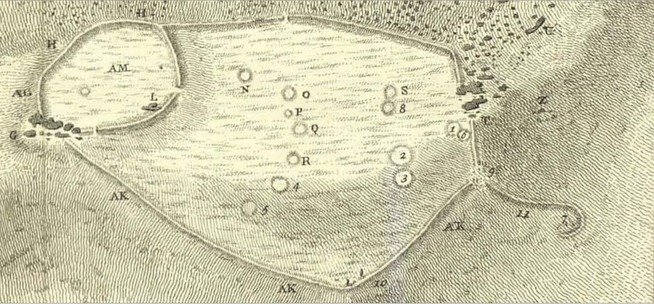Britain's earliest recorded serpent mound is the cute curl at the right of this 1754 plan. Why no older references? Wed 27 April 2022
William Borlase's 1754 plan of Carn Brae serpent mound, Cornwall. Source
Spelling varies: Carn Brae or Carn Brea. Earlier: Karnbré.
From Observations on the Antiquities Historical and Monumental of the County of Cornwall, William Borlase, 1754, p106:
...there is a mound thrown up on one side of Karnbre hill, (a place remarkable for Druid monuments of every kind) in a serpentine form, and in the center of its voluta there are two tall stones-erect standing by each other;
From page 115:
South-east from this group of ten stones, there runs a ridge (mark’d 11.) of earth, in a serpentine figure, which in the Voluta (meaning spiral) of it’s scroll, (No. 7.) has two very high and large stones set on end; the distance between them twelve feet.

Borlase's 1754 plan of Carn Brae serpent mound, Cornwall. Source: Observations on the Antiquities Historical and Monumental of the County of Cornwall, p113.
Carn Brea: (Google Maps), (Google Streetview), (OpenStreetMap), (NLS), (Flickr images)
Roughly, here:
Locations in this evidence collection
Borlase said Carn Brae serpent mound was the eastern extension of Carn Brae castle's complex of walls. He assessed the walls as being more suited for segrating people than for defense.
Wikipedia's description of Carn Brae castle says:
It is considered a folly, due to the huge uncut boulders that make up part of its foundations, giving the impression of the building melting into the land.

Carn Brae castle around 2000. Source
Borlase, though, said Carn Brae castle was old and a ruin by 1754, not a folly.

Pre-1754 view of Carn Brae Castle. Source: Observations on the Antiquities Historical and Monumental of the County of Cornwall, p113.
This was certainly a British building, and erected in thole uncultivated ages, when such rocky, hideous situations were the choice of of warlike, rough and stern minds.
He said the original builders had gone to considerable effort to bridge the gaps between the rocks to maximise the castle's unusual ground plan:

Pre-1754 view of Carn Brae Castle plan. Source: Observations on the Antiquities Historical and Monumental of the County of Cornwall, p113. -->
And he noted the oak woods near Carn Brae castle had been burned or removed for charcoal within the previous 50 years or so. From Observations on the Antiquities Historical and Monumental of the County of Cornwall, p 113:
The top of this hill is thick set with karns, or groups of rocks, and the spaces between and below, were in the memory of the last generation fill’d with a grove of Oaks; now there are no trees, but the places where those trees were chark’d, (or burnt into charcoal) are still to be seen.
Perhaps, like Grimsby's serpent mound, some parts of the area had experienced extreme heat.

Uneven rocks at Carn Brae. Source
© All rights reserved. The original author retains ownership and rights.
More of this investigation:
Serpent Mounds
More by tag:
#mounds, #Tennyson friend
